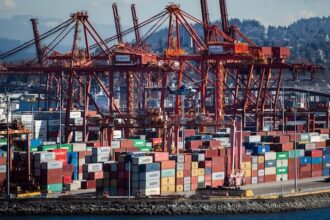The sound of hammers has fallen silent across construction sites in Vancouver as builders grapple with the sudden economic aftershock of new American tariffs on Canadian lumber. What began as a trade policy announcement in Washington has rapidly evolved into a crisis for Canada’s housing market, with lumber prices surging 27% in just three weeks.
“We’ve halted foundation work on fifteen homes this month alone,” says Michael Chen, president of Pacific Northwest Developments. “When your primary building material jumps by a quarter in price overnight, the math simply doesn’t work anymore.”
The 25% tariff, implemented by the Trump administration on October 1st, targets Canadian softwood lumber—the essential material for residential construction throughout North America. The administration cited “unfair subsidies” to Canadian producers as justification, despite five previous World Trade Organization rulings that rejected similar claims.
Industry data from the Canadian Home Builders Association reveals the immediate economic damage: an estimated 12,300 housing starts have been delayed or cancelled nationwide, with British Columbia bearing the heaviest burden at 4,100 projects. For a country already struggling with housing affordability, these numbers represent more than statistics—they represent families unable to find homes.
The ripple effects extend beyond construction sites. At CO24 Business, our analysis of employment data shows 8,700 lumber and construction workers have received layoff notices since the tariff announcement. Mills in northern communities like Prince George have reduced operations to single shifts, while some smaller operations have shut down entirely.
The tariffs create a peculiar economic contradiction. While designed to protect American lumber producers, early evidence suggests the policy may backfire spectacularly. Housing economists at RBC note that reduced Canadian production has created supply shortages throughout North America, driving prices higher for American builders as well.
“This isn’t just a Canadian problem anymore,” explains Dr. Anita Sharma, chief economist at the Canadian Construction Association. “When housing costs rise in Seattle, Portland, and across the northern states, it hurts American consumers directly. We’re looking at potentially $9,000 in additional costs for an average American new home.”
Political tensions continue mounting as Canadian officials lobby for reconsideration. Prime Minister Trudeau has characterized the tariffs as “damaging to citizens on both sides of the border” while promising retaliatory measures if negotiations fail. Industry sources at CO24 Sports report that even hockey stick manufacturing—an iconic Canadian industry—faces disruption as specialized lumber becomes prohibitively expensive.
For ordinary Canadians, the consequences appear increasingly dire. Vancouver real estate analyst Jordan Williams projects a 5.2% increase in new home prices by year-end, with further increases likely if the dispute remains unresolved. “The cruel irony is that a policy ostensibly about fair trade will make housing even less affordable for first-time buyers who had nothing to do with this dispute.”
As lumber shipments sit idle at border crossings and housing starts plummet, the question looms: will economic reality force a reconsideration of policy, or will homebuyers on both sides of the border pay the price for political brinkmanship? For the latest developments on this evolving story, follow our CO24 Breaking News coverage.







